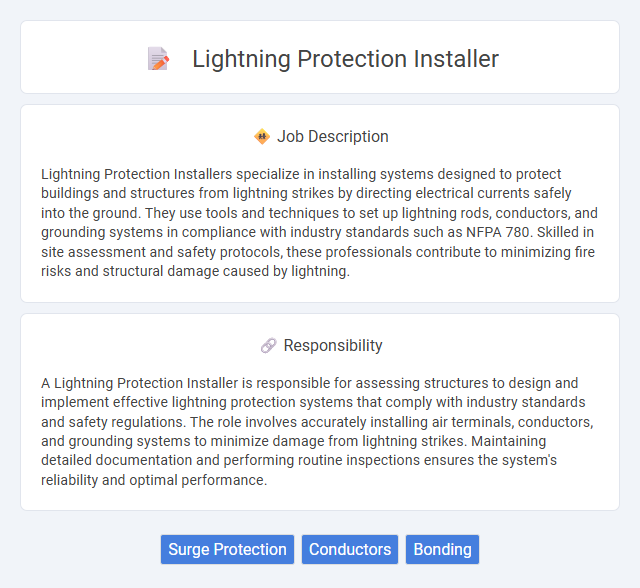
Lightning Protection Installers specialize in installing systems designed to protect buildings and structures from lightning strikes by directing electrical currents safely into the ground. They use tools and techniques to set up lightning rods, conductors, and grounding systems in compliance with industry standards such as NFPA 780. Skilled in site assessment and safety protocols, these professionals contribute to minimizing fire risks and structural damage caused by lightning.
Individuals who are physically fit and comfortable working at heights are more likely to be suitable for a Lightning Protection Installer job, as the role often requires climbing and handling heavy equipment. Those with a strong attention to detail and the ability to follow precise safety protocols probably find this position aligns well with their skills. People who prefer routine office work or have a fear of heights might find this job challenging or less suitable.
Qualification
A Lightning Protection Installer requires specialized training in electrical systems and a strong understanding of lightning risk assessment. Certification from recognized bodies such as the National Fire Protection Association (NFPA 780) demonstrates proficiency in installing grounding systems and surge protection devices. Experience with safety protocols and the ability to read technical blueprints are essential qualifications for ensuring effective and compliant lightning protection installations.
Responsibility
A Lightning Protection Installer is responsible for assessing structures to design and implement effective lightning protection systems that comply with industry standards and safety regulations. The role involves accurately installing air terminals, conductors, and grounding systems to minimize damage from lightning strikes. Maintaining detailed documentation and performing routine inspections ensures the system's reliability and optimal performance.
Benefit
Lightning Protection Installer jobs probably offer stable employment opportunities due to increasing demand for safety measures in residential, commercial, and industrial buildings. Workers likely gain specialized skills that enhance their employability and may receive competitive wages along with potential benefits such as health insurance and paid training. The role might also provide opportunities for career advancement in the electrical or construction industries.
Challenge
Lightning Protection Installer roles often involve working in physically demanding environments, requiring frequent climbing and handling of heavy equipment. The challenge of accurately assessing the risk of lightning strikes and installing protective systems to safeguard structures may require strong technical knowledge and attention to detail. There is a probability of encountering unpredictable weather conditions, which can impact both safety and installation efficiency.
Career Advancement
Lightning protection installers gain expertise in assessing structures for optimal lightning safety, installing grounding systems, and maintaining surge protection devices to minimize electrical hazards. Mastery in advanced installation techniques and certification in national electrical codes can lead to supervisory or project management roles within electrical contracting firms. Pursuing specialized training in risk assessment and system design further enhances career growth opportunities in engineering consultancy and safety compliance sectors.
Key Terms
Surge Protection
Lightning Protection Installers specialize in the installation and maintenance of surge protection systems that safeguard electrical and structural components from voltage spikes caused by lightning strikes. Their expertise ensures the integration of surge arresters, grounding systems, and shielding to prevent equipment damage and electrical fires. Proper surge protection installation is critical for maintaining the safety and functionality of residential, commercial, and industrial properties exposed to lightning risks.
Conductors
Lightning protection installers specialize in the precise placement and secure fastening of conductors to safely channel lightning strikes from rooftops and structures to the ground. They ensure conductors are made of highly conductive materials such as copper or aluminum with appropriate sizing to handle high current loads and prevent damage or fire hazards. Proper installation follows national electrical codes and standards like NFPA 780 to guarantee optimal system performance and occupant safety.
Bonding
Lightning Protection Installers specialize in bonding systems to ensure electrical continuity and minimize potential differences during lightning strikes. They connect metallic components such as structural steel, grounding rods, and conductor cables to create an effective low-resistance path for lightning currents. Proper bonding installation reduces the risk of fire, equipment damage, and electrical hazards by maintaining a unified grounding system.
 kuljobs.com
kuljobs.com